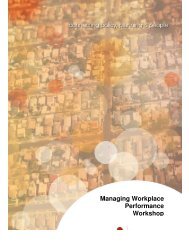Teenage Pregnancy Research Report - 3p Consulting
Teenage Pregnancy Research Report - 3p Consulting
Teenage Pregnancy Research Report - 3p Consulting
Create successful ePaper yourself
Turn your PDF publications into a flip-book with our unique Google optimized e-Paper software.
The local contextAs outlined in the literature the capacity to access positiveemotional support and good physical care are the mostcrucial components that optimise health outcomes forbaby and teen mother. The young women participating inthis research instinctively understood this and, whatevertheir circumstances, actively sought to have in placeelements of care for themselves and their babies whilethey were pregnant.The local contextHowever, while addressing physical and medical healthconcerns are of understandable importance, they areonly part of a myriad of competing issues that ariseduring pregnancy. It is factors associated with teenagers’pre-pregnancy lives that have the most impact on youngpeople choices, behaviour and outcomes at this time.A prime motivator during pregnancy for all the researchparticipants was the need to prepare for the birth oftheir baby. This meant being conscious of taking care ofoneself physically and finding support. Priorities focusedon some or all of the following:• forming significant and supportive relationships,• finding stable housing,• achieving some sort of financial income and• maintaining relationship with their partnersDepending on if these elements were in place, the nextin importance was adjusting their lifestyle and accessingantenatal care and birth preparation.These priorities are explored more fully in this section ofthe report.Forming significant and supportiverelationshipsAs outlined in the previous section, the theme of seekingsignificant relationships while being sexually active isextended through to pregnancy. The single most commonexperience for young women was the separation fromtheir primary family at the time of pregnancy. Thisoccurred for many young women either prior to pregnancyor at the time of, regardless of other risk factors includingsocio-economic background, poverty and risky lifestylebehaviour or other circumstances of their lives.Where the family relationship may have been disengagedprior to pregnancy, the relationship with the family wassometimes re-established as a result of the pregnancy.Where this happened, outcomes such as having stablehousing and continuing to go to school were more likelyfor the young woman during the pregnancy.While many of the research participants describedhaving difficult relationships with their families, theyall sought to “bond” with at least one adult once theyrealised they were pregnant. Regardless of theircircumstances, young women sought to establish,maintain or re-establish a relationship with a key“other”. This ranged from their own parent/s, partner’smother or father, a grandmother or in some cases,a trusted service provider. For those young womenwho were estranged from their own family, manyreported a supportive relationship at least initially withtheir boyfriend’s mother. A key factor that engenderedtrust in these young women was being proactivelysupported. This included being taken to antenatalappointments, being offered room in the house andmeals, being there for support and advice acrossthe range of issues that arose. In two cases theserelationships continued even if the young women andher boyfriend were no longer together.HousingThe single biggest issue facing pregnant teens is tofind and maintain stable and suitable housing. Thecycle of moving house that started before pregnancyfor many of the young people, continued throughtheir pregnancy and into parenthood. Across theyoung women interviewed, the average number ofhouse moves during pregnancy was three. Ten of the67



